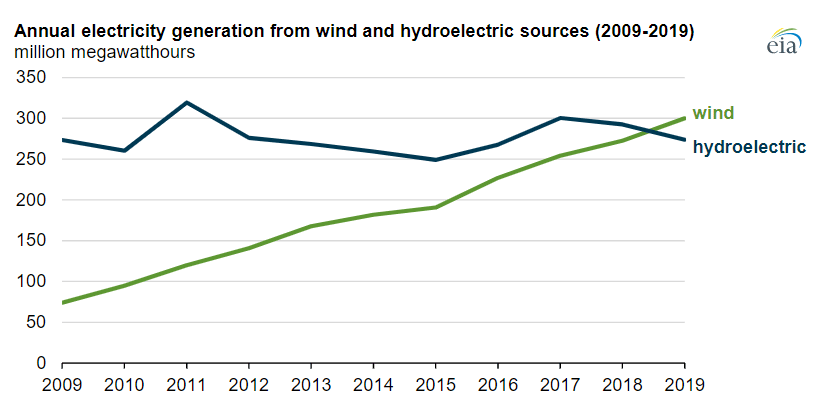Wind Outpaces Hydro as the Top Renewable Electricity Source in 2019: EIA

U.S. annual wind electricity generation surpassed hydropower for the first time in 2019 to become the largest source of renewable electricity generation in the U.S., according to a Feb. 26 report from the U.S. Energy Information Administration. Although total installed capacity of wind power exceeded that of hydro in 2016, it wasn’t until last year that wind overtook hydroelectric generation.
- Annual wind generation totaled 300 million megawatt-hours in 2019, outdoing hydroelectric generation by 26 million MWh.
- Wind generation rose steadily during the past decade due, in part, to the extension of the federal production tax credit, which drove wind capacity additions.
- Annual hydropower output has fluctuated between 250 million MWh and 320 million MWh in the past decade, reflecting a stable capacity base and variable annual precipitation.
- The U.S. added 10 gigawatts of wind capacity in 2019, with 3.8 gigawatts installed in the fourth quarter, making 2019 the second-largest year for wind additions after 2012.
- As of the end of 2019, the United States had 103 gigawatts of wind capacity, with about 77 percent installed in the past decade.
- U.S. hydropower capacity totals 80 gigawatts, most of which has been operating for several decades; only 2 gigawatts of hydroelectric capacity have been added in the past decade, and some of those involved converting previously nonpowered dams.
- Between 2009 and 2019, the average annual capacity factors for the U.S. hydroelectric fleet ranged from 35 percent to 43 percent, while those of the wind fleet were lower, ranging from 28 percent to 35 percent.
EnerKnol Pulses like this one are powered by the EnerKnol Platform—the first comprehensive database for real-time energy policy tracking. Sign up for a free trial below for access to key regulatory data and deep industry insights across the energy spectrum.
ACCESS FREE TRIAL